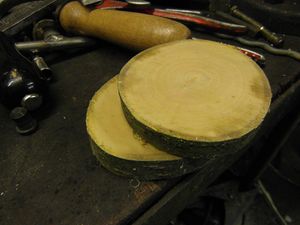Project:Drying Timber
From CoMakingSpace Wiki
| ProjectInfoBox Drying Timber | |
|---|---|

| |
| Status: | ongoing |
| Release Date: | hoping for first products in 2017 |
| Initiator: | Lukas |
| Materials Used: | various kinds of wood |
| Tools Used: | hacksaw, drawknife |
Before actively looking for sources of unprocessed timber or rough-cut boards for projects like a "river table", I want to experiment with drying and storage techniques to see which works best. Drying too fast will cause the wood to crack while incomplete drying allows fungi to grow.
Different woods are tested as they probably won't behave alike.
Pine

- few weeks old log from the forest
- bark mostly gone already
- stored in uninsulated attic since 2016-9-25
- not too great - used as chop block and eventually burned in May 2017
Apple

- fresh log from an orchard
- cut into pieces for various approaches
- 1.5 cm discs with and without bark
- untreated log
- log with cuts painted over
- log with bark removed and cuts painted over
- stored in garage (logs) or basement/attic (discs) since 2016-10-03
Cherry & Maple
- two small pieces from a gardener at the JKI Dossenheim
- bark left intact, left outside for about two months after cutting
- too long - already had several cracks when getting painted 2017-02-19
Beech
- small log from a fallen tree
- "marbled" with some kind of fungus (spalting)
- sawn & left outside since 2017-02-05, cut faces painted 2017-02-19 (already too late!)
- stored in attic since 2017-02-20
Further Ideas
- will need to get/make a moisture meter
- there is an instructable on kiln drying at home, but it seems to require lots of space and electricity
- try using a wood glue and water mixture to seal the faces, might be cheaper and ecologically safer than lacquer
- wood discs can reportedly be placed in a bucket of sawdust to dry, be treated with "wood hardener" or weighed down in a stack and rotated every few weeks
- not tried yet, but as they are really hard to dry it's best to not cut the timber into discs when still fresh!